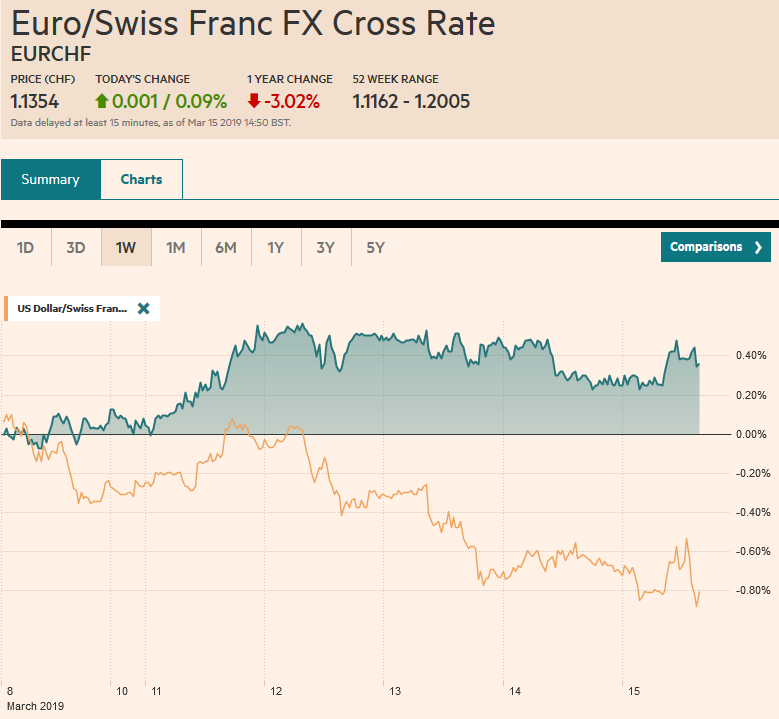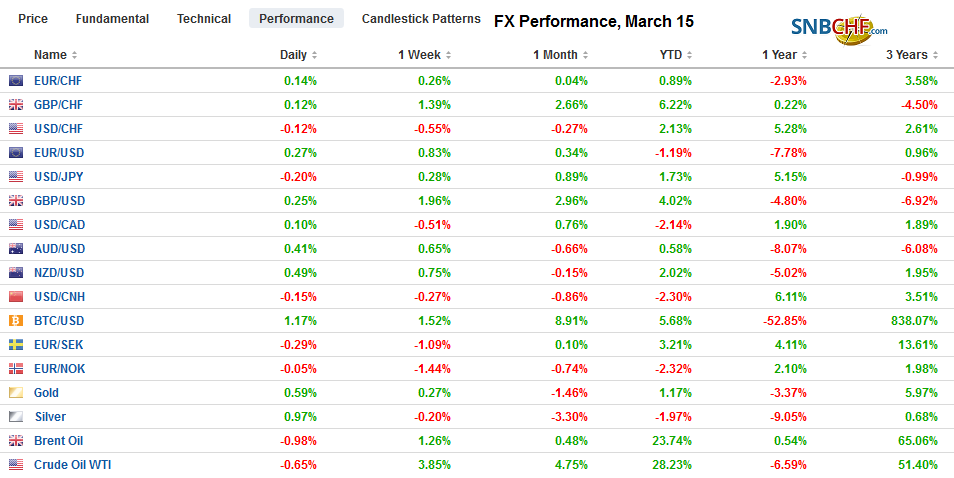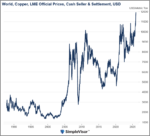Swiss FrancThe Euro has risen by 0.09% at 1.1354 |
EUR/CHF and USD/CHF, March 15(see more posts on EUR/CHF, USD/CHF, ) Source: markets.ft.com - Click to enlarge |
FX RatesOverview: The capital markets are calm ahead of the weekend. Outside of Australia and Thailand, Asia Pacific equities advanced, while European shares are mostly little changed. The regional benchmarks, like the S&P 500 have recouped last week’s losses. Benchmark 10-year yields are little changed on the day, leaving the US 10-year yield virtually unchanged on the week near 2.62%. The benchmark Japanese government bond yield has hovered around minus five basis points, while European bond yields were mostly a little higher, except for Italy, where the yield has eased around three basis points to 2.52%. The US dollar is softer against all the major currencies and most of the emerging market currencies. The dollar has traded with a heavier bias this week, following the disappointing headline job creation reported a week ago. |
FX Performance, March 15 |
Asia Pacific
The Bank of Japan stuck to its knitting. As widely anticipated, policy was unchanged. The central bank cut its assessment of exports, industrial output, and foreign growth, in line with the recent string of economic data. There continued to be two dissents (Kataoka and Harada) from a more dovish position. While many Japanese officials recognize that the 2% inflation target is not realistic, there has been so much that has been sacrificed in its name, there is a reluctance to abandon it. There is also a problem with the credibility of the new target. In its own way, the BOJ appears to have stumbled into the fallacy of sunk costs. The other problem is that Japan is committed to raising the sales tax in October to 10% from 8%. Even though the government is trying to soften the blow through consumption incentives, the economy, which contracted in H2 does not have strong growth impulses in the early part of 2019.
China’s National People’s Congress session has come to an end. Premier Li reaffirmed CNY2 trillion tax cuts will go into effect on April 1. The other significant policy initiative is a new law that ostensibly provides for equal treatment of foreign and domestic firms and bans forced technology transfers. What China says, its declaratory policy, is rarely an issue. Officials often seem to say the right things. It is the operational policy, what it does, where the proverbial rubber hits the road, that is problematic.
The Japanese yen is the only major currency to slip against the US dollar this week. It is off a little more than 0.5% with the greenback near JPY111.70. The dollar has traded in a single yen range this week. It had begun the week, slipping briefly through JPY111.00 and set the week’s high just shy of JPY112.00 in early Asia, where a nearly $400 mln expiring option is struck. There are also about $950 mln in options that will also roll off today between JPY111.50 and JPY111.65. Three-month implied volatility is easing to new five-year lows today near 5.6%. During the flash crash at the start of the year, the implied volatility reached almost 10%. The Australian dollar is set to snap a three-week decline with a gain of around 0.5% (~$0.7080). The Aussie has been capped by the 20-day moving average, which is found now near $0.7100, for nearly the past three weeks. The Chinese yuan is little changed this week (~CNY6.714). Starting last December, the yuan has fallen only one week per month and here in March that was last week, when the dollar rose nearly 0.25%.
Europe
Brexit keeps on giving. The next act in the drama is clear. There will be another vote on the Withdrawal Bill early next week. If it passes, May will seek a three-month extension to legislate it. However, if it does not pass, the length of the delay would be left in the EU’s hands. The Withdrawal Bill has been defeated resoundingly twice. Why will the third time be any different? This is how the brinkmanship is being played out. Each time, the alternatives are fewer. No one likes the Withdrawal Bill as the historic loss of the first vote demonstrated. There has been hope of an alternative, but the alternatives continue to get blocked and, May’s strategy is for those alternatives to be even more unpalatable than the Withdrawal Bill.
The stark alternative that the House of Commons will face next week is either approve the objectionable Withdrawal Bill, or there could be a potentially long extension that could lead to a reversal of the decision to leave. The Withdrawal Bill is likely to get more support than ever on the third try, but it most likely will not pass. Still, the third vote will not deal the last blow. There could be one last vote on it, after the EU’s summit next week but before the end of the month.
The euro has advanced in five of the six sessions since last week’s ECB meeting, which saw the euro fall to18-month lows near $1.1175. The high was recorded in the middle of the week near $1.1340. The euro has spent little time subsequently below $1.13 and looks poised to move higher. There price action in the North American morning is likely to be hampered by 2.8 bln euros in options in the $1.1310 to $1.1325 area that are set to expire. There are also 1.7 bln euros in options struck at $1.13 that will be cut today and another option for 630 mln euros at $1.1285. The euro’s three-month implied volatility is near 5.55% today, which is also a five-year low. Sterling fell 1.5% last week, and near $1.3250, it is up about 1.8% this week. Sterling appears to have been boosted by perceptions that the downside risks of an exit with a deal have been reduced. Investors seem to be wrestling with the uncertainty caused by a long delay and the possibility that there is a kernel of truth to the scare tactic that a delay will morph into revoking Article 50. Three-month implied volatility is near 10.3%, off about 0.25% this week.
America
The S&P 500 is up more than 12% year-to-date. The 10-year note yield is lower than it began the year. This appears to have removed some sense of urgency from the Trump Administration for a trade deal with China. President Trump makes it sound like it is now China that feels the string of urgency, but this seems to be a negotiating tactic. The latest reports suggest that the potential agreement is already 110-120 pages long. It still looks a few weeks away. Both sides want to host the two president summit. Trump is scheduled to be in Japan in late May; the trip could include a meeting with Xi. Trump says there can be no deal until Xi and he agree, but China wants an agreement before the meeting to avoid the fate of North Korea at the last meeting.
The US reports February industrial and manufacturing output. It is expected to recover after declines in January. The Empire Survey will offer an early glimpse into this month’s activity, and it is expected to rise for the second consecutive month. The preliminary March University of Michigan consumer sentiment should also tick up. The US economy hit a soft patch, which many mistakenly confused with a recession. It is already recovering. Canada reports January manufacturing sales. These should pick up after a 1.3% fall at the end of the year. However, February existing home sales likely unwound January’s 3.6% gain.
The US dollar slipped against the Canadian dollar since the diverging jobs report at the last week. It has only risen in one session since and was yesterday’s 0.25% gain. The 20-day moving average has offered support. It is found near CAD1.3280 today. Rising equities and oil have helped the Canadian dollar and its discount to the US on two-year money has narrowed by five basis points since the peak last week. The dollar has fallen against the peso like it has against the Canadian dollar since last week’s jobs report. The dollar has given back the previous week’s 1.1% gain this week, leaving it in an MXN19.24-MXN19.38 trading range over the past few sessions.
Graphs and additional information on Swiss Franc by the snbchf team.
Full story here Are you the author? Previous post See more for Next postTags: #GBP,#USD,$AUD,$CAD,$EUR,$JPY,EUR/CHF,MXN,newsletter,USD/CHF

































